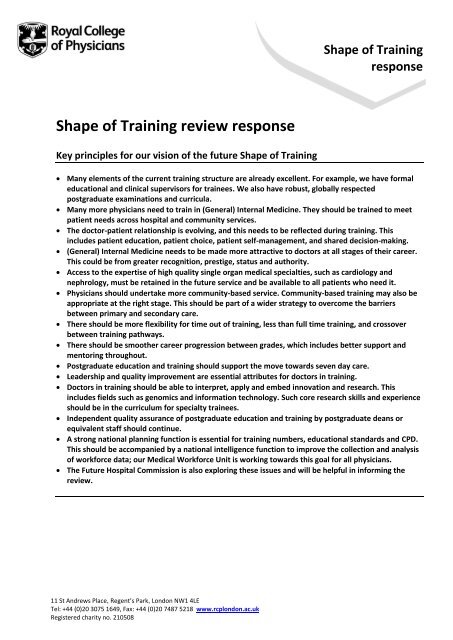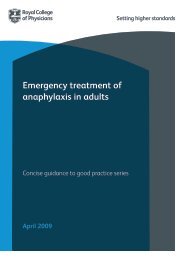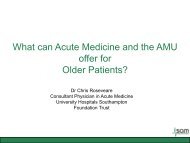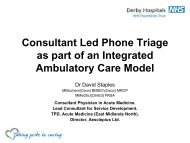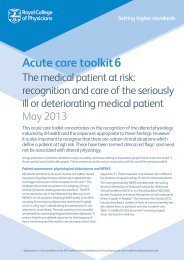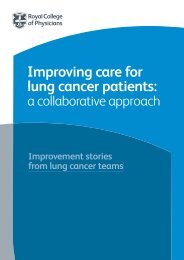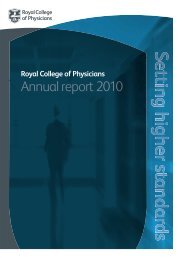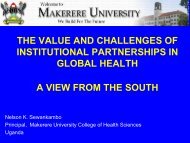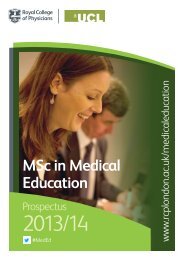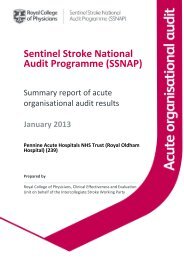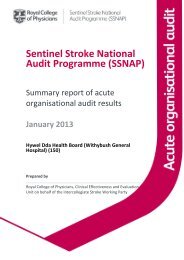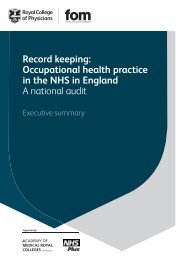Dr Andrew Hilson FRCP - Royal College of Physicians
Dr Andrew Hilson FRCP - Royal College of Physicians
Dr Andrew Hilson FRCP - Royal College of Physicians
Create successful ePaper yourself
Turn your PDF publications into a flip-book with our unique Google optimized e-Paper software.
Shape <strong>of</strong> TrainingresponseShape <strong>of</strong> Training review responseKey principles for our vision <strong>of</strong> the future Shape <strong>of</strong> Training Many elements <strong>of</strong> the current training structure are already excellent. For example, we have formaleducational and clinical supervisors for trainees. We also have robust, globally respectedpostgraduate examinations and curricula. Many more physicians need to train in (General) Internal Medicine. They should be trained to meetpatient needs across hospital and community services. The doctor-patient relationship is evolving, and this needs to be reflected during training. Thisincludes patient education, patient choice, patient self-management, and shared decision-making. (General) Internal Medicine needs to be made more attractive to doctors at all stages <strong>of</strong> their career.This could be from greater recognition, prestige, status and authority. Access to the expertise <strong>of</strong> high quality single organ medical specialties, such as cardiology andnephrology, must be retained in the future service and be available to all patients who need it. <strong>Physicians</strong> should undertake more community-based service. Community-based training may also beappropriate at the right stage. This should be part <strong>of</strong> a wider strategy to overcome the barriersbetween primary and secondary care. There should be more flexibility for time out <strong>of</strong> training, less than full time training, and crossoverbetween training pathways. There should be smoother career progression between grades, which includes better support andmentoring throughout. Postgraduate education and training should support the move towards seven day care. Leadership and quality improvement are essential attributes for doctors in training. Doctors in training should be able to interpret, apply and embed innovation and research. Thisincludes fields such as genomics and information technology. Such core research skills and experienceshould be in the curriculum for specialty trainees. Independent quality assurance <strong>of</strong> postgraduate education and training by postgraduate deans orequivalent staff should continue. A strong national planning function is essential for training numbers, educational standards and CPD.This should be accompanied by a national intelligence function to improve the collection and analysis<strong>of</strong> workforce data; our Medical Workforce Unit is working towards this goal for all physicians. The Future Hospital Commission is also exploring these issues and will be helpful in informing thereview.11 St <strong>Andrew</strong>s Place, Regent’s Park, London NW1 4LETel: +44 (0)20 3075 1649, Fax: +44 (0)20 7487 5218 www.rcplondon.ac.ukRegistered charity no. 210508
Shape <strong>of</strong> TrainingresponseIntroduction and response to question 1. Over the next 30 years, how do you thinkthe way patients are cared for will change?Future patient needs must drive service requirements, which in turn must drive any training reforms. Toconsider future patient needs, it is essential to begin from the current situation.Current situationAt present, patient needs are not being adequately met, as detailed in our Hospitals on the Edge? The timefor action. 1 Distressingly, for some patients even the most basic elements <strong>of</strong> care have been neglected,such as at Stafford Hospital or Winterbourne View private hospital. The final report <strong>of</strong> the Mid StaffordshireNHS Foundation Trust Public Inquiry by Robert Francis QC is a reminder that training ultimately needs toensure that patient care is not compromised.Many factors seem to contribute to this inadequacy <strong>of</strong> inpatient care. There has been a significantlyincreased clinical workload, with emergency admissions increasing by over 37% over the last decade. Also,65% <strong>of</strong> people admitted to hospital are now over 65 years old, and this group will consult their GP twice as<strong>of</strong>ten as younger adults; the majority <strong>of</strong> them have at least one long term condition. 2There is also a lack <strong>of</strong> continuity <strong>of</strong> care in hospitals. This was the top concern <strong>of</strong> patients and <strong>of</strong> ourmembers in 2012 and over a quarter <strong>of</strong> consultants thought continuity <strong>of</strong> care was poor or very poor intheir hospital. 3,4 Unnecessary patient moves between acute, general or specialist wards, and the lack <strong>of</strong> out<strong>of</strong>-hoursprovision by the relevant workforce also results in increased morbidity and mortality. 1Compounding this, there is a worsening workforce crisis in hospitals. For consultants, the gap betweenwhat they work and they are contracted to work has been steadily increasing, to a mean <strong>of</strong> six hours extraper week (from two hours in 2006). More worryingly, <strong>of</strong> the medical registrars who sustain the acuteservice, a quarter report that their workload is unmanageable, and another two-thirds describe it as heavy. 5Future trendsWe have identified four main drivers to change, explored in our report, Future physician. 2 The first isdemography. There will be many more older people, one projection suggesting that by 2033 there will be3.2 million people over 85 years – from 0.6 million in 1983. The prevalence <strong>of</strong> dementia is expected todouble. Presently at least 15% <strong>of</strong> households comprise single dwellers over the state pension age. Certainlong term conditions, such as obesity and alcohol misuse, are set to continue increasing, with theirassociated complications.Secondly, there is a continuing shift in social trends. Patients have more choice and higher “expectations”than before, and the importance <strong>of</strong> the patient experience is rightly being recognised. Improving patientexperience requires a culture shift in the NHS. This is in agreement with the recent report by Robert FrancisQC. We have produced a national guideline covering individualised care, respect for patients, patientconcerns, personal needs, open communication, and access to information. 6 We support activeparticipation by patients in their own care, from shared decision making to self-management <strong>of</strong> long termconditions.11 St <strong>Andrew</strong>s Place, Regent’s Park, London NW1 4LETel: +44 (0)20 3075 1649, Fax: +44 (0)20 7487 5218 www.rcplondon.ac.ukRegistered charity no. 210508
Shape <strong>of</strong> TrainingresponseTechnology will be another major driver. The internet will continue to make available more healthcareinformation and services, as well as enabling ratings and feedback <strong>of</strong> such services. An electronic patientrecord allows for more efficient and safer consultations. This could be owned by or accessible to patients.Medical research has been accelerating and will lead to clinical applications in fields such as genomics,imaging, pharmaceuticals and nanotechnology.Finally, changes to patient care, service provision or medical training must be underpinned by efficiencyand cost-effectiveness. The economy will shape services substantially, and in the short-term we know thatthe NHS faces unprecedented austerity. This is an opportunity to meet patient needs more efficiently in anyreforms to training.Future medical workforceRegarding the number <strong>of</strong> physicians needed for the service, we believe that more doctors must train in(General) Internal Medicine. These have broader knowledge, broader skills and greater diagnostic abilitythan other specialists. They will be able to build on the advances we have seen in specialty medicine,thereby bringing new treatments, technologies and high levels <strong>of</strong> care to all patients, including those withmultiple, complex conditions. Doctors trained and deployed effectively to use their expert skills in diagnosisand patient management could play a crucial role in coordinating this care, managing input to a patient’scare from multiple specialties as appropriate.The Shape <strong>of</strong> Training review refers to such doctors as ‘generalists.’ Such a term does not accurately reflectthe substantial training and expertise required. Furthermore, it implies that ‘generalism’ is inferior to otherspecialties, whereas internal medicine should be recognised as the most important and most challengingspecialty in acute care. We therefore urge the review to drop the terms ‘generalist’ and ‘generalism.’ Forthe current ‘General Internal Medicine’ pathway, we advocate ‘Internal Medicine,’ but to avoid confusion,we use the term ‘(General) Internal Medicine’ herein.Hospitals need more (General) Internal Medicine physicians to provide the best care for the many olderpeople and those with multiple long term conditions. Our forthcoming Future <strong>of</strong> the Medical Registrarreport shows that acute medical registrars have a workload that is increasing annually, and they feelundervalued and poorly respected by management. 8 We shall forward the final report for consideration byyour review.We propose a coordinated programme <strong>of</strong> short and long term activity to promote (General) InternalMedicine at all levels, involving the structure and organisation <strong>of</strong> the service, as well as education, trainingand careers pathways. In the shorter term, much can be done by looking at how we deploy our doctors,many <strong>of</strong> whom already have a good base <strong>of</strong> (General) Internal Medicine skills. We shall need to explorehow we could deploy existing skills in different ways, ensuring a more even distribution <strong>of</strong> activity andintensity across the workforce. Medical rotas – including the spread <strong>of</strong> doctors contributing to the acutetake and the rota <strong>of</strong> medical registrars – and the way in which we train in (General) Internal Medicine (suchas moving to more structured daytime training) must be reviewed. If the workload associated with(General) Internal Medicine were more manageable, it would be a more attractive option for many doctorsin training and then into the later stages <strong>of</strong> their careers.11 St <strong>Andrew</strong>s Place, Regent’s Park, London NW1 4LETel: +44 (0)20 3075 1649, Fax: +44 (0)20 7487 5218 www.rcplondon.ac.ukRegistered charity no. 210508
Shape <strong>of</strong> TrainingresponseThe expansion <strong>of</strong> this workforce needs to go hand-in-hand with greater attractiveness <strong>of</strong> (General) InternalMedicine to all doctors, and it should not be part <strong>of</strong> a process doctors pass through to reach the next stage<strong>of</strong> their career. Greater continuity <strong>of</strong> patient care will aid this. The Commission also proposes greaterinfluence and responsibility for future physicians in this specialty. We believe that (General) InternalMedicine consultants are well-suited to leadership roles given the breadth <strong>of</strong> clinical experience that theywill have, and their broader view <strong>of</strong> care. This greater responsibility and prestige is another way in whichsuch a career could be made more attractive to trainees and doctors.In the future, a more structured approach to promoting the expert skills and knowledge needed to deliver(General) Internal Medicine in the way and at the level described here, should be considered. It may bethat a dedicated (General) Internal Medicine specialty will become possible and practical. However, this willneed further consideration and a period <strong>of</strong> transition.There is a growing need for doctors to be familiar with research, such as in genomics and informationtechnology. All doctors should value, understand and apply relevant research throughout their clinicalpractice. The best researchers should continue to be allowed into a separate stream to maximise theirresearch effectiveness, but sometimes only for the active part <strong>of</strong> their career. At the same time, thereshould be more flexibility to allow such trainees to re-enter clinical work, and to allow clinical trainees andconsultants to take time out for research.Future Hospital CommissionThe RCP is exploring all <strong>of</strong> these topics as part <strong>of</strong> its Future Hospital Commission. The Commission is lookinginto how we can improve hospital services, taking into account the current issues and drivers <strong>of</strong> future care.The Commission is chaired by Sir Michael Rawlins, with stakeholders including patients, other <strong>Royal</strong><strong>College</strong>s, the Academy <strong>of</strong> Medical Sciences, the Care Quality Commission, Public Health England and theNHS Confederation. Its findings will be reported in the summer, but some themes have already becomeclear from the Commission’s work. 7One emerging theme is that healthcare pr<strong>of</strong>essionals should provide holistic, compassionate andindividually tailored care, which considers co-morbidities and mental wellbeing. Multi pr<strong>of</strong>essionalteamwork and leadership are vital. Overall care should be seamless between primary, secondary, and socialcare. This should be reflected in individualised care plans for patients. Having medical practitioners workingacross these interfaces will help, and this may include general practitioners (GPs) with special interests,community specialists and GPs working in hospitals. Social care and public health need to be much moreengaged with hospital care.There also needs to be greater seven day access to services, both in primary and secondary care. Patientsshould be assessed and treated more rapidly by competent, trained practitioners. Within hospitals, thereshould be greater continuity <strong>of</strong> care. This is likely to require changing work patterns to ensure continuity inacute medical rotas with fixed teams, and also reducing transfers <strong>of</strong> patients between wards. Whentransfers occur between divisions in a hospital, there should still be access to specialists and high-level carebeds.The RCP looks forward to continuing to work with the Shape <strong>of</strong> Training review as the Future HospitalCommission develops its final recommendations.11 St <strong>Andrew</strong>s Place, Regent’s Park, London NW1 4LETel: +44 (0)20 3075 1649, Fax: +44 (0)20 7487 5218 www.rcplondon.ac.ukRegistered charity no. 210508
Shape <strong>of</strong> Trainingresponse2. What will this mean for the kinds <strong>of</strong> doctors that will be needed in primarycare? In secondary care? In other kinds <strong>of</strong> care?Recommendations A single regulator should continue to operate across the UK, with consistent and equal standards <strong>of</strong> careand training. All types <strong>of</strong> doctors should be <strong>of</strong>fered more flexible job plans to allow less than full time working, careerbreaks and a healthier work-life balance. There should be a structured consultant career with further pr<strong>of</strong>essional development and learningthroughout. Primary care physicians need to be trained to manage multiple acute and long term conditions. Primary and community care should be easily accessible to all. More primary care physicians should work in hospital, for example in ambulatory care. More consultants in (General) Internal Medicine will be needed to provide acute and intermediate care.This includes involvement in community care, such as in care homes, and care <strong>of</strong> patients in otherhospital specialties. Subspecialists in tertiary care will be essential and will continue to work in regional centres <strong>of</strong> excellencein areas <strong>of</strong> highly specialised knowledge or where there are specific procedures.Background The primary care physician <strong>of</strong> the future will be critical in selecting and explaining investigations andtreatments effectively for patients with more complex needs, including multiple acute and long termconditions. Embracing shared decision making and self management <strong>of</strong> conditions will help to achievethis. The GP or community physician should be there to deal with complexity and uncertainty, adding valuefrom a more sophisticated clinical examination and making clinical judgements that are notstraightforward. A significant amount <strong>of</strong> the basic day-to-day interaction may then be undertaken bynon-physicians, such as physician associates or practice nurses. Physician associates can also help trainees focus on learning opportunities. Primary care services should be <strong>of</strong>fered throughout the week and to the whole population. This includesless independent people in the community, such as nursing home residents or those with mental illness. Other non-physicianly specialties need to consider adequate training for looking after their patients. It will be necessary for physicians to play a greater role in the peri-operative and post-operativemanagement <strong>of</strong> surgical patients, as now in ‘orthogeriatrics.’ One radical idea is that all patients in hospital, except paediatric, obstetric, and gynaecology patients,are admitted under (General) Internal Medicine. Some specialties will work best in regional centres <strong>of</strong> excellence with large catchment areas, and otherswill work best <strong>of</strong>fering community care closer to home. Both aspects need to be considered whendeciding how to organise secondary care.11 St <strong>Andrew</strong>s Place, Regent’s Park, London NW1 4LETel: +44 (0)20 3075 1649, Fax: +44 (0)20 7487 5218 www.rcplondon.ac.ukRegistered charity no. 210508
Shape <strong>of</strong> Trainingresponse3. What do you think will be the specific role <strong>of</strong> general practitioners (GPs) in all <strong>of</strong>this? The role <strong>of</strong> GPs is to become more aligned with the population’s primary care needs outlined above, andpatient consultation may help further define this role. GPs should endeavour to be an effective and trusted primary point <strong>of</strong> contact for patients, in terms <strong>of</strong>access, continuity <strong>of</strong> care, shared decision making and diagnostic ability, throughout the week. Continuing Pr<strong>of</strong>essional Development (CPD) could be delivered through the local hospital and with moreemphasis placed upon it. Minor illness can be devolved to other groups <strong>of</strong> staff, who are overseen by GPs. GPs will work more closely with secondary care, including hospital inreach. Likewise, physicians will bemore involved in community care, especially for patients with long term conditions.4. If the balance between general practitioners, generalists and specialists will bedifferent in the future, how should doctors’ training (including GP training)change to meet these needs?Recommendations Medical school curricula and clinical rotations should reflect the needs <strong>of</strong> patients and the balance <strong>of</strong>the future workforce. Community placements for medical students and some trainees should be considered. Graduate entry into medical school should be encouraged, as entry at this level brings useful qualities. GPs will need additional training, particularly in medical specialties, paediatrics, psychiatry, andmedicine <strong>of</strong> old age, to better manage long term and degenerative conditions. (General) Internal Medicine should be seen as an attractive and highly valued career option, equal toother specialties. This is essential to reverse the current decline in numbers training for dualaccreditation. Most specialist training will need to be underpinned by a knowledge and practice <strong>of</strong> (General) InternalMedicine, as does GP training. This includes physicianly and non-physicianly specialties that currently donot participate in (General) Internal Medicine.Background There should be some common training between GPs and secondary care doctors to help break downbarriers between the two groups. One option to deliver this is for a broad-based or core medical trainingprogramme for all GP trainees. Our data show that over 90% <strong>of</strong> medical registrars describe their acute care workload as ‘heavy’ or‘unmanageable.’ 5 Patients with long term conditions would like to have easier access to physicians when needed. More training in (General) Internal Medicine is needed to provide a workforce that can meet theincreasing demand on acute medical services. This will take the form <strong>of</strong> increased numbers <strong>of</strong> traineesparticipating in (General) Internal Medicine, and/or increased time spent in (General) Internal Medicine.11 St <strong>Andrew</strong>s Place, Regent’s Park, London NW1 4LETel: +44 (0)20 3075 1649, Fax: +44 (0)20 7487 5218 www.rcplondon.ac.ukRegistered charity no. 210508
Shape <strong>of</strong> Trainingresponse5. How can the need for clinical academics and researchers best be accommodatedwithin such changes?Recommendations Trainees need to have the pr<strong>of</strong>essional judgement to interpret, apply and embed innovation andresearch. Such core research skills and experience should be in the curriculum for specialty trainees. The NHS must nurture the next generation <strong>of</strong> clinical research leaders. No part <strong>of</strong> the workforce should be deprived <strong>of</strong> academic capacity and leadership. Research training opportunities should exist throughout the career pathway. Research funders need to be involved in discussions <strong>of</strong> changes to postgraduate training.Background The government has committed to generating a culture <strong>of</strong> research throughout the NHS workforce. Todeliver this, we must encourage research awareness among all trainees by providing appropriateresearch experience. Patients are supportive <strong>of</strong> the need for clinical research, which can promote learning from excellence. There are low numbers <strong>of</strong> women in research and this needs to be addressed. To maximise the benefits <strong>of</strong> research to patient care, strong academic leadership is essential and wemust ensure that the NHS encourages the next generation <strong>of</strong> clinical research leaders. For those who are undertaking the highest level <strong>of</strong> academic activity, such as those on a MRCprogramme or academic clinical fellows and lecturers, there is a case that these should be funded andmanaged as separate stream. However, clinical capabilities must still be acquired as for non-academictrainees. Academic trainees traditionally move into more specialist roles. If the review recommends a change ingeneralist and specialist training, care must be taken to ensure that no part <strong>of</strong> the workforce is deprived<strong>of</strong> academic capacity and leadership. Individuals will develop an interest in pursuing academic training at different stages <strong>of</strong> their careers. Research funders need to be involved in discussions <strong>of</strong> changes to postgraduate training, as changes tothe training pathway could have implications for funding capacity. It is critical that anyrecommendations emerging from the Shape <strong>of</strong> Training review do not inadvertently have a negativeimpact on research. We highlight the Academy <strong>of</strong> Medical Sciences’ response to this consultation, which outlines more detailaround making appropriate provisions for research training that will help to ensure that the workforce isequipped to benefit from research.11 St <strong>Andrew</strong>s Place, Regent’s Park, London NW1 4LETel: +44 (0)20 3075 1649, Fax: +44 (0)20 7487 5218 www.rcplondon.ac.ukRegistered charity no. 210508
Shape <strong>of</strong> Trainingresponse6a. How would a more flexible approach to postgraduate training look in relationto doctors in training as employees?Recommendations Doctors in training need to have protected flexibility in their career choices and progression. Local organisations, with advice from the postgraduate dean, should continue to be responsible foremploying secondary care doctors, rather than a regional or national body. The length <strong>of</strong> placements should be reviewed. There should be blocks <strong>of</strong> training and service delivery in (General) Internal Medicine. Using more physician associates may help provide this flexibility for trainees across all specialties.Background Training and service delivery are integral to one another. Doctors in training should be employees andconsider themselves to be so. However the Department <strong>of</strong> Health and Health Education England should recognise that doctors intraining need to have protected flexibility in their career choices and progression. Employers need to raise their engagement with trainees, and we welcome their involvement in LocalEducation and Training Boards (LETBs). Local organisations should continue to be responsible foremploying secondary care doctors, rather than a regional or national body. The length <strong>of</strong> placements should be reviewed. We do not generally support placements for longerthan a year in order to maximise the number <strong>of</strong> different experiences and opportunities that a traineeobtains during their training programme. However, a longer placement may allow for greaterengagement with the local employer. There should be blocks <strong>of</strong> training and service delivery in (General) Internal Medicine, whichevermodel is applied. These blocks, possibly <strong>of</strong> 3-6 months, will provide continuity <strong>of</strong> care both for patientsand for the multi pr<strong>of</strong>essional team. Hence trainees would remain part <strong>of</strong> a larger team, and couldconcentrate on their specialty training for a defined part <strong>of</strong> the year. Trainees should not spend one orsome days in (General) Internal Medicine before going back to specialty training. Patients feel that better clinical and training outcomes would be achieved if trainees had time to formrelationships with their patients and to follow a patient journey through from admission to discharge. Structured training is important for trainees, particularly with access to supervision throughout theworking day.11 St <strong>Andrew</strong>s Place, Regent’s Park, London NW1 4LETel: +44 (0)20 3075 1649, Fax: +44 (0)20 7487 5218 www.rcplondon.ac.ukRegistered charity no. 210508
Shape <strong>of</strong> Trainingresponse6b. How would a more flexible approach to postgraduate training look in relationto the service and workforce planning?Recommendations The move to seven day services in both primary and secondary care should be taken into accountwhen planning the future service and workforce. There needs to be an expansion <strong>of</strong> the trained (General) Internal Medicine workforce. There needs to be a more even distribution <strong>of</strong> the (General) Internal Medicine workload among allspecialties. Specialty and subspecialty numbers will all need to be planned nationally. There should be provision <strong>of</strong> training opportunities and protected time for high quality research.Background There is an imbalance between the number <strong>of</strong> undergraduates and trainees in London and elsewherein the country, as well as between centres <strong>of</strong> excellence and district general hospitals. This needsfurther consideration and was highlighted by the Academy <strong>of</strong> Medical <strong>Royal</strong> <strong>College</strong>s. Doctors in training need appropriate supervision and there needs to be a long term movementtowards the service relying less and less on doctors in training under little supervision. However, thiscan only be achieved with an expansion <strong>of</strong> the trained (General) Internal Medicine workforce. For physicians, a larger number <strong>of</strong> both trainees and consultants with training in (General) InternalMedicine would allow more flexibility in delivering the acute service and prevent the unmanageableworkload <strong>of</strong> acute medicine falling on the few. This group <strong>of</strong> doctors could train in other specialtiesalongside, or after (General) Internal Medicine training, using a shorter specialist curriculum. Workload should be more evenly distributed between all specialties, and not in the few specialtiesthat cover acute medicine. The Future <strong>of</strong> the Medical Registrar report highlights the presentunmanageable workload <strong>of</strong> medical registrars. 8 Specialty and subspecialty trainee numbers will particularly need to be planned nationally by HealthEducation England, the <strong>Royal</strong> <strong>College</strong>s, specialist societies, postgraduate deans and LETBs. 9 However, workforce changes cannot take place without service change as well. The current need for efficiency savings and reform <strong>of</strong> the NHS should not distract from the importance<strong>of</strong> providing high quality research training opportunities and protected time for research. The public and patients would like seven day services.11 St <strong>Andrew</strong>s Place, Regent’s Park, London NW1 4LETel: +44 (0)20 3075 1649, Fax: +44 (0)20 7487 5218 www.rcplondon.ac.ukRegistered charity no. 210508
Shape <strong>of</strong> Trainingresponse6c. How would a more flexible approach to postgraduate training look in relationto the outcome <strong>of</strong> training – the kinds and functions <strong>of</strong> doctors?Recommendations There needs to be a better balance <strong>of</strong> workload in the trained workforce with more activity in(General) Internal Medicine. Increased training is needed in (General) Internal Medicine for most, if not all, physicians. A number <strong>of</strong>models are suggested to achieve this. The Future Hospital Commission will provide a more detailed analysis <strong>of</strong> these models.Background There is a need for a better balance in workforce activity in medicine. (General) Internal Medicineprovides holistic care and other specialties greatly aid the management <strong>of</strong> specific conditions. Therewill be many shared capabilities between these groups, and there needs to be balanced deployment <strong>of</strong>their expertise with, in general, more involvement in (General) Internal Medicine. As outlined above, increased training is needed in (General) Internal Medicine for most, if not all,physicians. Models for this include:o Widening participation into (General) Internal Medicine in the short term. The number <strong>of</strong>trainees undertaking a CCT in (General) Internal Medicine can be increased as part <strong>of</strong> a dualtraining pathway with another specialty. Dual training can be enforced for more traineesand more specialties.o Alternatively, there could be a longer period <strong>of</strong> broad-based or core medical training,followed by shorter specialty training.o Similarly, early years <strong>of</strong> specialty training could include much more time in (General)Internal Medicine. This would enable all trainees to obtain a CCT in (General) InternalMedicine after specialty training.o Another option is to consider a separate specialty <strong>of</strong> (General) Internal Medicine, whichwould have to be made attractive to trainees; otherwise recruitment to this will be difficult.It should be considered at least the equal <strong>of</strong>, if not more important than, other specialties.o A more radical option is to require all physicians in training to achieve a CCT in (General)Internal Medicine and then go on to practise in (General) Internal Medicine or then train inother specialties. Planning the workforce requirements in this scenario may be morecomplicated.o Some models might encourage Trusts to consider a subconsultant grade to carry out theacute workload. We do not favour this.o In all <strong>of</strong> our models, we envisage that most consultant physicians would contribute more tothe (General) Internal Medicine service.11 St <strong>Andrew</strong>s Place, Regent’s Park, London NW1 4LETel: +44 (0)20 3075 1649, Fax: +44 (0)20 7487 5218 www.rcplondon.ac.ukRegistered charity no. 210508
Shape <strong>of</strong> Trainingresponse6d. How would a more flexible approach to postgraduate training look in relationto the current postgraduate medical education and training structure itself(including clinical academic structures)?Recommendations Medical school curricula and the Foundation Programme should be reviewed. Preparation forFoundation year 1, the value <strong>of</strong> Foundation year 2, and the degree <strong>of</strong> emphasis on management <strong>of</strong>long term conditions should all be reviewed. A two or three year broad-based training programme for some trainees could contribute to (General)Internal Medicine training requirements, as well as leading on to training programmes for GPs,psychiatrists and other specialties. Such a programme must comprise at least six months in (General)Internal Medicine. Capabilities should be based on knowledge and skills required by the majority <strong>of</strong> the post-CCTpractitioners. They should be transferable between specialties. There should be a more flexible, phased consultant career. Post-CCT training should be nationally managed. The regulator and the <strong>Royal</strong> <strong>College</strong>s should ensure that standards are maintained. Taught MSc or MD degrees in clinical subjects or health services research should be available to all. Individual trainees should have flexibility to take time out <strong>of</strong> training for research or other out-<strong>of</strong>programmeexperiences. This includes geographical flexibility.Background The Foundation Programme should be reviewed. This includes the need for specialist rotations and theneed for greater focus on management <strong>of</strong> long term conditions. The purpose <strong>of</strong> Foundation year 2 should be evaluated. The broad-based programme could include (General) Internal Medicine, community care, psychiatry,and general practice. Consideration should be given to when community care rotations, supervised byspecialists, are most useful for trainees and patients. This may be later in training. Narrow subspecialist capabilities should be removed from the training curriculum and perhaps addedas post-CCT credentials for a subgroup <strong>of</strong> CCT holders in that specialty. An implication <strong>of</strong> the above is that training up to CCT is likely to contain more (General) InternalMedicine. There could then be part-time training, probably in competition, to develop furthersubspecialty experience and credentialed experience. However, this post-CCT training needs to continue to be managed, and assessed to the highestpossible standard. It also needs to be planned on a national basis, with deaneries and colleges workingtogether. As far as possible, capabilities should be transferable between specialties not only for physicians, butalso for those wishing to move into other disciplines. LETBs will allow service providers to map training requirements to local service posts. Here it is crucialthat the regulator and the <strong>Royal</strong> <strong>College</strong>s ensure that training standards are maintained. Academic trainees are required to complete academic training alongside gaining clinical competencies,for example by taking time out to complete a PhD. The needs <strong>of</strong> individual trainees must be taken intoaccount and training programmes must enable them to take time out <strong>of</strong> the clinical training pathway,11 St <strong>Andrew</strong>s Place, Regent’s Park, London NW1 4LETel: +44 (0)20 3075 1649, Fax: +44 (0)20 7487 5218 www.rcplondon.ac.ukRegistered charity no. 210508
Shape <strong>of</strong> Trainingresponseand to move back into it at an appropriate point. Such flexibility would be aided by moving to acapability-based curriculum.This not only applies to research, but to those who wish to take time out <strong>of</strong> training for voluntarywork, medical education, and medical management or leadership.Trainees may also have unique requirements in terms <strong>of</strong> geographical flexibility, which is difficult toachieve in the current arrangements. For example, it may be difficult for some trainees to transfertheir academic work to a new location, because they are working with a particular patient populationor they require specific laboratory facilities. Equally, other trainees may need to move to a certainlocation to pursue their research or other out-<strong>of</strong>-programme experience.Training programmes should plan for this with additional capacity so that the service implications donot become a surprise.11 St <strong>Andrew</strong>s Place, Regent’s Park, London NW1 4LETel: +44 (0)20 3075 1649, Fax: +44 (0)20 7487 5218 www.rcplondon.ac.ukRegistered charity no. 210508
Shape <strong>of</strong> Trainingresponse7. How should the way doctors train and work change in order to meet theirpatients’ needs over the next 30 years?Recommendations Doctors should be trained to provide holistic care, to be pr<strong>of</strong>essional, to understand concepts, such asrisk management, and to be able to assess research evidence. Consultants should have dedicated time to train doctors. Continuity <strong>of</strong> care is essential in all medical settings for effective training. There should be an aspirationtowards a single named physician being responsible for the care pathway <strong>of</strong> each patient. Most training should occur in the setting in which a doctor will primarily be working.Background Holistic care includes taking responsibility for aspects such as compassion, dignity, pain relief, hydrationand nutrition. More (General) Internal Medicine experience in different settings may help to deliver this. Doctors should also be trained in pr<strong>of</strong>essionalism, that is a set <strong>of</strong> values, behaviours, and relationshipsthat underpins the trust the public has in doctors. In any clinical encounter, there must be a partnershipbetween patient and doctor, one based on mutual respect, individual responsibility, and appropriateaccountability. 10 For example, this includes shared decision making and supporting patients in tacklingobesity or smoking. Doctors must be committed to the values <strong>of</strong> integrity, altruism, compassion, continuous improvement,excellence and working in multi pr<strong>of</strong>essional environments. 10 There needs to be training in patient safety and risk management, with more openness about medicalerrors. One <strong>of</strong> our options allows for a grade <strong>of</strong> doctor that is both providing service in independent practiceand studying part-time in a supervised fashion to obtain credentials. This would be a new way <strong>of</strong>working for the NHS. However these doctors must be able to continue to progress, and must not besubconsultants. Consultants need to have dedicated time to train, and this must be recognised in their job plans. Our2010 census showed that 52% <strong>of</strong> consultants had less time to spend with their trainee than three yearsago, with only 14% saying they had more time. 5 Continuity <strong>of</strong> care is essential. In acute or (General) Internal Medicine, this would mean a continuous‘block’ <strong>of</strong> shifts for all grades <strong>of</strong> doctors on the rota, rather than more frequent, fragmented shifts. Inthe community, this may mean greater availability and access to doctors. Most training for any doctor should occur in the setting in which they will be primarily working. This maymean partly community and secondary care environments for physicians, rather than tertiary carecentres. Patients want integrated care with named responsible physicians, particularly in hospitals. As far aspossible, a single physician should provide continuity <strong>of</strong> care during an admission. This is also highlightedin the recent report by Robert Francis QC. <strong>Physicians</strong> are likely to play a greater role in the management <strong>of</strong> other patient groups, such as surgicaland obstetric perioperative care.11 St <strong>Andrew</strong>s Place, Regent’s Park, London NW1 4LETel: +44 (0)20 3075 1649, Fax: +44 (0)20 7487 5218 www.rcplondon.ac.ukRegistered charity no. 210508
Shape <strong>of</strong> Trainingresponse8. Are there ways that we can clarify for patients the different roles andresponsibilities <strong>of</strong> doctors at different points in their training and career anddoes this matter?Recommendations Retain the term ‘consultant’ for trained practitioners Engage with trainees and patient groups to identify the best terms for other groups <strong>of</strong> doctors. ‘Generalist’ is not a useful term for patients or doctors in training. Greater continuity <strong>of</strong> care by trainees will also help reduce confusion <strong>of</strong> doctors’ roles amongst patients.Background We accept that there is an ongoing problem with the number <strong>of</strong> terms for trainees – ‘trainees’, ‘juniordoctors’, ‘house <strong>of</strong>ficers’, ‘specialty registrars’, ‘specialist registrars’, and so forth. Some <strong>of</strong> these olderterms are still being used. We suggest working particularly with trainees and patient groups to identify how to improve this. To avoid confusion amongst the public, it would be best to retain the term ‘consultant’ for any trainedpractitioners at CCT-level. One idea is to display the grade <strong>of</strong> doctor more prominently, such as with coloured badges.9. How should the rise <strong>of</strong> multi pr<strong>of</strong>essional teams to provide care affect the waydoctors are trained?Recommendations Medical leadership and management need to become more important in training. There areopportunities for interpr<strong>of</strong>essional learning in these areas. There is no evidence to support the emphasis on greater multi pr<strong>of</strong>essional approach to education, butthere may be limited opportunities in some areas. Trainees should not be disadvantaged by working in environments in which other healthcarepr<strong>of</strong>essionals do work that overlaps with trainees’ duties. However, there needs to be effective teamwork during many clinical activities, such as ward rounds,multi disciplinary team meetings and surgical procedures. The role <strong>of</strong> other healthcare pr<strong>of</strong>essionalsshould be appreciated by trainees.Background Doctors are trained in the environment in which clinical practice is delivered. As clinical practice isbecoming more multi pr<strong>of</strong>essional, it is inevitable that trainees will learn in these multi pr<strong>of</strong>essionalenvironments. Doctors should be encouraged to lead and be responsible for patients, their outcomes and their safety.This should be a natural extension <strong>of</strong> existing medical training into problem solving, risk assessment, andcommunication with patients. To foster this, the training environment itself could be accredited for specific multi pr<strong>of</strong>essionalteamwork criteria. This may be suited towards post-CCT credentials.11 St <strong>Andrew</strong>s Place, Regent’s Park, London NW1 4LETel: +44 (0)20 3075 1649, Fax: +44 (0)20 7487 5218 www.rcplondon.ac.ukRegistered charity no. 210508
Shape <strong>of</strong> Trainingresponse There must be clear differentiation between interpr<strong>of</strong>essional learning and a multi pr<strong>of</strong>essionalapproach to education and training. There are opportunities for interpr<strong>of</strong>essional learning for areas <strong>of</strong> the curriculum such as leadership andmanagement, and clear opportunities in the service field for the multidisciplinary training (such as instroke services) <strong>of</strong> consultants, physiotherapists, nurses and pharmacy staff for the purposes <strong>of</strong> CPD. However, there is no evidence to support the emphasis on a much greater multi pr<strong>of</strong>essional approachto education. Trainee medical specialists, for example, have particular education needs, which wouldnot be met in multi disciplinary training sessions. Any changes to the system should recognise thesedifferences.10. Are the doctors coming out <strong>of</strong> training now able to step into consultant leveljobs as we currently understand them?Recommendations Broader, necessary capabilities should form a greater part <strong>of</strong> training curricula and replace somecurrent narrower capabilities. There should be a much more formal structure <strong>of</strong> bringing people into an independent practitionerrole, which should include mandatory mentoring <strong>of</strong> new consultants for the first few years. Phased consultant grades should be considered.Background For physicians, most doctors coming out <strong>of</strong> training are competent in their field. The CCT shouldcontinue to signal the capability for independent practice in that particular field. However, we are aware that they have less experiental training. They need greater team support andmentoring in the first years <strong>of</strong> a consultant appointment. We also note that some new consultantsstruggle not from lack <strong>of</strong> knowledge or skill, but because <strong>of</strong> the more difficult pr<strong>of</strong>essionalexpectations. This is reinforced by the notion <strong>of</strong> all consultants being equal. Conversely, there are areas <strong>of</strong> subspecialised medicine in which it is not reasonable to expect traineesto achieve pr<strong>of</strong>iciency before CCT. These would be suited to post-CCT credentials and should bereplaced by broader, necessary capabilities. To resolve this, there should be a much more formal structure <strong>of</strong> bringing people into an independentpractitioner role, which should include mandatory mentoring <strong>of</strong> new consultants for the first fewyears. This could be achieved by having different, phased grades <strong>of</strong> consultant such as principal consultantsrather than by having a pre-consultant grade. There should be a method to allow more experienced trainees to ‘act up’ as a consultant undersupervision, to ease the transition between grades. A more specific induction and support mechanism should be considered. This has <strong>of</strong>ten failedpreviously and needs to be ably planned and implemented.11 St <strong>Andrew</strong>s Place, Regent’s Park, London NW1 4LETel: +44 (0)20 3075 1649, Fax: +44 (0)20 7487 5218 www.rcplondon.ac.ukRegistered charity no. 210508
Shape <strong>of</strong> Trainingresponse11. Is the current length and end point <strong>of</strong> training right?Recommendation A minimum length <strong>of</strong> time, with capability-based progression and assessment should determine theend point <strong>of</strong> training. Broader, necessary capabilities should form a greater part <strong>of</strong> training curricula and replace somecurrent narrower subspecialist capabilities. (General) Internal Medicine should form a greater proportion <strong>of</strong> the pre-CCT curriculum. There aredifferent options for this. There should be national standards set by the <strong>Royal</strong> <strong>College</strong>s for post-CCT training. All consultants should continue high quality CPD. Academic trainees should have time to complete both clinical and academic training.Background There should be no compulsory or rigid length <strong>of</strong> training to obtain a CCT. Instead, a minimum length<strong>of</strong> time, with capability-based progression and assessment should determine the end point <strong>of</strong> training. There are too many requirements in the pre-CCT curriculum for physicians currently. For each medical specialty, there may be scope to move highly subspecialist knowledge and skills intopost-CCT credentialing curricula. Instead, the pre-CCT curriculum would focus on more knowledge and skills related to (General)Internal Medicine. These are discussed more fully in question 6c.o One option is for dual accreditation pathways in (General) Internal Medicine and aspecialty, but only at an ‘intermediate level’ for the specialty prior to CCT in (General)Internal Medicine.o Another option is initial single accreditation in (General) Internal Medicine for some ormost trainees, before further specialisation in (General) Internal Medicine or anotherspecialty.o Yet another option is for pre-CCT credentialing, in which a set <strong>of</strong> credentials can confirmcapability in a certain area and lead to a CCT. Post-CCT training should be more formally acknowledged, encouraged and nationally managed to highstandards. It is essential that academic trainees have the time to complete both clinical and academic training.They should be able to progress at a pace that reflects their clinical and academic abilities. Moving to acompetency, rather than time-based, system would help. Trainees should be actively involved inplanning their competency acquisition and in conversations about their progression.11 St <strong>Andrew</strong>s Place, Regent’s Park, London NW1 4LETel: +44 (0)20 3075 1649, Fax: +44 (0)20 7487 5218 www.rcplondon.ac.ukRegistered charity no. 210508
Shape <strong>of</strong> Trainingresponse12. If training is made more general, how should the meaning <strong>of</strong> the CCT changeand what are the implications for doctors’ subsequent CPD?Recommendations The meaning <strong>of</strong> the CCT would remain the regulatory standard for independent practice. There should be phased consultant grades with more formal clinical management oversight <strong>of</strong> thoseappointed after CCT. Academic training opportunities must remain attractive in terms <strong>of</strong> pay and conditions, relative to theclinical training pathway.Background The CCT is a nationally recognised requirement by employers and the General Medical Council. It isimportant for the service and employer to understand that many or most physicians will underg<strong>of</strong>urther post-CCT training. This could be facilitated if there were phased consultant grades with more formal clinical managementoversight <strong>of</strong> those appointed post-CCT as independent practitioners. However the RCP is opposed to asubconsultant service grade, which will be demoralising. There should be a more structured development plan covering leadership, management, education,research, and quality improvement. This should align with the phased consultant career structure. Any change to the point at which CCT is awarded could have significant implications for researchfunders who fund academic training posts. Current funding for academic training posts and PhDs is atthe level <strong>of</strong> clinical trainee. Therefore research funders should be actively consulted in any suchdiscussions as their capability to maintain the current level <strong>of</strong> support may be affected.13. How do we make sure doctors in training get the right breadth and quality <strong>of</strong>learning experiences and time to reflect on these experiences?Fundamentally this is about restructuring the workforce to ensure that those training to CCT are ableto focus more on their education and training, rather than coping with an unmanageable workload.There will be much greater flexibility <strong>of</strong> post-CCT credentialing to ensure that the standards are fullymet by those moving on to more subspecialty areas.In terms <strong>of</strong> content <strong>of</strong> learning experiences, we believe that all doctors should learn about genomics,information technology, medicine <strong>of</strong> old age, and research methodology.It is vital that post-CCT subspecialisation or credentialing is nationally planned, nationally funded andnationally accredited. The <strong>Royal</strong> <strong>College</strong>s will play an important part in this.11 St <strong>Andrew</strong>s Place, Regent’s Park, London NW1 4LETel: +44 (0)20 3075 1649, Fax: +44 (0)20 7487 5218 www.rcplondon.ac.ukRegistered charity no. 210508
Shape <strong>of</strong> Trainingresponse14. What needs to be done to improve the transitions as doctors move betweenthe different stages <strong>of</strong> their training and then into independent practice?Recommendations There needs to be more graduated transitions between grades, including a phased consultant grade.There should be training specific to each grade, especially for new consultants. Transfer <strong>of</strong> information on trainees between different employers should be encouraged as long asthey comply with doctors’ employment rights.Background A more structured consultant workforce could ensure that the transitions are far more carefullymanaged, particularly into independent practice, than they are now. For a transition to independent practice as a consultant, there should be training in understanding NHSsystems (such as commissioning and Trust functions), business plans, clinical governance (such asnational audits, standards, and outcomes) and litigation. Transfer <strong>of</strong> information on trainees between different employers will help protect patients andsupport doctors. Learning needs can then be identified after a transition. This should comply withdoctors’ employment rights. For academic trainees, there must be sufficient opportunities to move into senior academic posts. It is essential that individuals in academic training have the flexibility to balance clinical and academicduties at the postdoctoral level, both before and after the point <strong>of</strong> CCT, so that they build anindependent research career. This is a vital step in developing the next generation <strong>of</strong> academicleaders. There should be more opportunity for consultants at all stages <strong>of</strong> their career, by agreement with theiremploying organisation, to change their workload mix.15. Have we currently got the right balance between trainees delivering serviceand having opportunities to learn through experience?No. Currently many young doctors are spending too much time on ‘out-<strong>of</strong>-hours’ cover <strong>of</strong> a largenumber <strong>of</strong> patients, rather than participating in other important educational activities, such asoutpatient clinics or community care.This is a fundamental concern, particularly for medical registrars. There needs to be a substantial shiftin the balance towards learning and structured training. 8This will be helped by more trainees regularly taking part in (General) Internal Medicine.11 St <strong>Andrew</strong>s Place, Regent’s Park, London NW1 4LETel: +44 (0)20 3075 1649, Fax: +44 (0)20 7487 5218 www.rcplondon.ac.ukRegistered charity no. 210508
Shape <strong>of</strong> Trainingresponse16. Are there other ways trainees can work and train within the service? Shouldthe service be dependent on delivery by trainees at all?Recommendation There needs to be more involvement in (General) Internal Medicine by trained physicians as well astrainees. This will enable a better balance between training and service delivery.Background Trainees cannot always learn unless they are delivering service in their future environment. The balance between training activities and service delivery may need to comprise more trainingactivities in the earlier part <strong>of</strong> training, with progressive supervised service delivery in the latter part. Giving importance to continuity <strong>of</strong> care in rota design will allow trainees to learn more effectively andappreciate patient journeys and outcomes. Unless trainees have access to patients and form relationships with patients, they will not be preparedfor delivering care. However, there would need to be an enormous increase in consultant numbers to provide full 24-hourcover, and this may be neither practical nor necessary.17. What is good in the current system and should not be lost in any changes?We emphasise that there is much to be admired in current UK postgraduate training. The RCP and theFederation <strong>of</strong> <strong>Royal</strong> <strong>College</strong>s <strong>of</strong> <strong>Physicians</strong> has developed a globally respected examination. It is onethat is increasingly sophisticated and mapped on to training curricula.Workplace-based assessments and curricula themselves are well-written, rigorous, objective andcontinuously improved.The current commitment by thousands <strong>of</strong> educators and supervisors, including many <strong>of</strong> our members,to the training <strong>of</strong> junior doctors is exemplary. It is still regarded as an important and rewarding activitydespite the time, the effort, and frequent lack <strong>of</strong> proper resources.A good supervisor-trainee relationship allows for better experiental learning. This apprenticeshipmodel is also useful outside <strong>of</strong> the medical specialties.At a regional level, via Schools, the gradual reintegration <strong>of</strong> education, deanery functions(responsibility for curriculum delivery) and <strong>Royal</strong> <strong>College</strong> functions has been a very positive andwelcome development. All sides need to collaborate with each other in the future, and this shouldcontinue in the new environment <strong>of</strong> postgraduate deans, LETBs and Health Education England.Training <strong>of</strong> doctors in all environments, and not only in tertiary ‘teaching hospitals,’ raises standardsaround the UK and prepares people for the reality <strong>of</strong> clinical practice. This should continue and beencouraged nationally.Quality <strong>of</strong> research in the NHS is currently high, thanks to the work <strong>of</strong> the National Institute for HealthResearch, including the Integrated Academic Training Pathway. This opportunity should build upon thesuccesses already seen and ensure that we are able to maximise the benefits <strong>of</strong> research to patientsover the next 30 years and beyond.11 St <strong>Andrew</strong>s Place, Regent’s Park, London NW1 4LETel: +44 (0)20 3075 1649, Fax: +44 (0)20 7487 5218 www.rcplondon.ac.ukRegistered charity no. 210508
Shape <strong>of</strong> Trainingresponse18. Are there other changes needed to the organisation <strong>of</strong> medical education andtraining to make sure it remains fit for purpose in 30 years time that we havenot touched on so far in this written call for evidence?Accreditation <strong>of</strong> training environments should be considered, alongside the proposals for accreditation<strong>of</strong> trainers.Using technology can greatly enhance teaching and training. Such opportunities should be recognisedand embraced.There has never been a better time for medical education research and this should also beencouraged.It is crucial that proposed changes to education and training also consider service design, serviceplanning and, in England, service commissioning.There is currently poor data on the medical workforce, and our Medical Workforce Unit is keen to helpresolve this issue. Better data will allow reforms to better meet patient and trainee needs.We believe that the <strong>Royal</strong> <strong>College</strong> <strong>of</strong> <strong>Physicians</strong> has an important role in quality assurance at a nationallevel for any future changes in the shape <strong>of</strong> training.11 St <strong>Andrew</strong>s Place, Regent’s Park, London NW1 4LETel: +44 (0)20 3075 1649, Fax: +44 (0)20 7487 5218 www.rcplondon.ac.ukRegistered charity no. 210508
Shape <strong>of</strong> TrainingresponseReferences1. <strong>Royal</strong> <strong>College</strong> <strong>of</strong> <strong>Physicians</strong>. Hospitals on the edge? The time for action. London: RCP; 2012. Availableat: http://www.rcplondon.ac.uk/sites/default/files/documents/hospitals-on-the-edge-report.pdf.2. <strong>Royal</strong> <strong>College</strong> <strong>of</strong> <strong>Physicians</strong>. Future physician: changing doctors in changing times. London: RCP; 2010.Available at: http://www.rcplondon.ac.uk/sites/default/files/documents/future-physician.pdf.3. <strong>Royal</strong> <strong>College</strong> <strong>of</strong> <strong>Physicians</strong>. Results <strong>of</strong> RCP Health and Social Care Bill survey. 2012. Available at:http://www.rcplondon.ac.uk/press-releases/results-rcp-health-and-social-care-bill-survey.4. <strong>Royal</strong> <strong>College</strong> <strong>of</strong> <strong>Physicians</strong>. Quarter <strong>of</strong> physicians say continuity <strong>of</strong> care is poor in their hospital. 2012.Available at: http://www.rcplondon.ac.uk/press-releases/quarter-physicians-say-continuity-care-poortheir-hospital.5. Federation <strong>of</strong> the <strong>Royal</strong> <strong>College</strong>s <strong>of</strong> <strong>Physicians</strong> <strong>of</strong> the UK. Census <strong>of</strong> consultant physicians and medicalregistrars in the UK. London: RCP; 2011.6. National Institute for Health and Clinical Excellence. Patient experience in adult NHS services:improving the experience <strong>of</strong> care for people using adult NHS services. CG138. London: National ClinicalGuideline Centre at the <strong>Royal</strong> <strong>College</strong> <strong>of</strong> <strong>Physicians</strong>; 2012. Available at:http://www.nice.org.uk/nicemedia/live/13668/58283/58283.pdf.7. <strong>Royal</strong> <strong>College</strong> <strong>of</strong> <strong>Physicians</strong>. What next for hospital services? Emerging themes from the FutureHospital Commission. London: RCP; 2012. Available at:http://www.rcplondon.ac.uk/sites/default/files/documents/future_hospital_commission_emerging_themes_-_october_2012.pdf.8. <strong>Royal</strong> <strong>College</strong> <strong>of</strong> <strong>Physicians</strong>. The future <strong>of</strong> the medical registrar. (in press); 2013.9. <strong>Royal</strong> <strong>College</strong> <strong>of</strong> <strong>Physicians</strong>. Liberating the NHS: Developing the healthcare workforce - RCPconsultation response. London: RCP; 2011. Available at:http://www.rcplondon.ac.uk/sites/default/files/consultation-response-to-liberating-the-nhsdeveloping-the-healthcare-workforce.pdf.10. <strong>Royal</strong> <strong>College</strong> <strong>of</strong> <strong>Physicians</strong>. Doctors in society: medical pr<strong>of</strong>essionalism in a changing world. Report <strong>of</strong>a Working Party <strong>of</strong> the <strong>Royal</strong> <strong>College</strong> <strong>of</strong> <strong>Physicians</strong> <strong>of</strong> London. London: RCP; 2005. Available at:http://bookshop.rcplondon.ac.uk/contents/pub75-241bae2f-4b63-4ea9-8f63-99d67c573ca9.pdf.11 St <strong>Andrew</strong>s Place, Regent’s Park, London NW1 4LETel: +44 (0)20 3075 1649, Fax: +44 (0)20 7487 5218 www.rcplondon.ac.ukRegistered charity no. 210508
Shape <strong>of</strong> TrainingresponseData protection and freedom <strong>of</strong> information request answersWe are responding on behalf <strong>of</strong> an organisation.We are ‘a postgraduate medical institution including a medical royal college or faculty.’Our organisation is based in England and Wales, and has joint responsibility for Northern Ireland with twoother <strong>Royal</strong> <strong>College</strong>s (RCPE and RCPSG).Our response is not confidential.11 St <strong>Andrew</strong>s Place, Regent’s Park, London NW1 4LETel: +44 (0)20 3075 1649, Fax: +44 (0)20 7487 5218 www.rcplondon.ac.ukRegistered charity no. 210508


